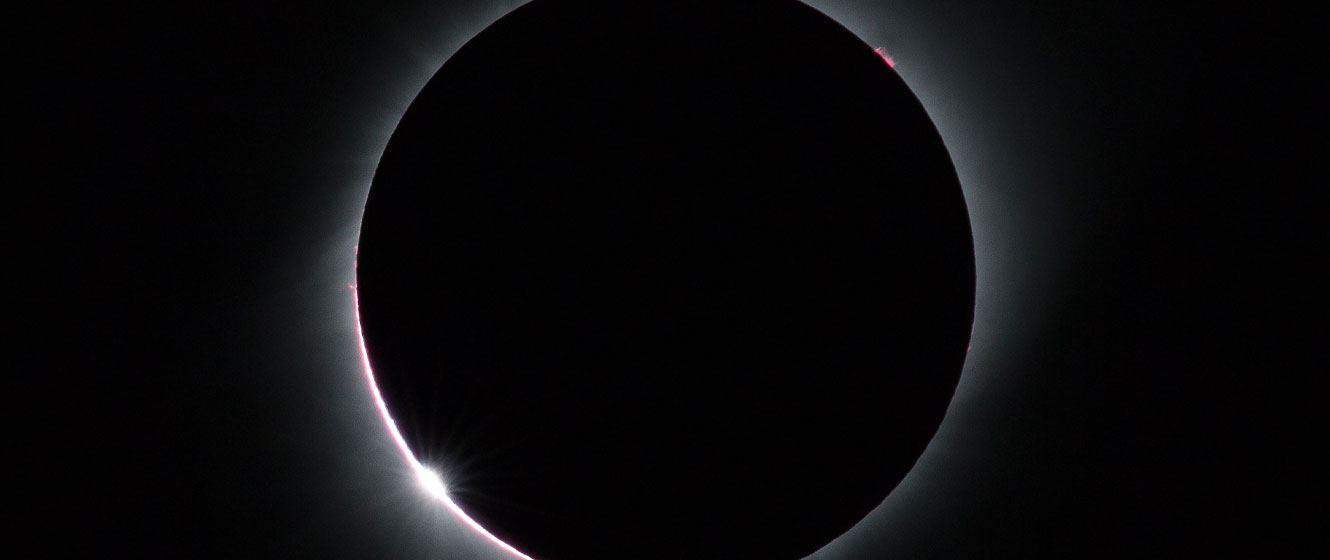
Solar eclipses are captivating celestial events that have fascinated humanity for centuries. Eclipses have transfixed and, in many times, startled civilizations with their brilliant display in the sky. These mesmerizing occurrences transpire when the Moon, in its celestial dance around our planet, aligns perfectly with the Sun, casting a shadow on Earth and momentarily plunging small slivers of the world into an eerie darkness.
In this article, we delve into the top 10 solar eclipses worldwide, both in the past and in the future. These extraordinary celestial phenomena have been carefully chosen based on various criteria, including the number of people who were fortunate enough to witness them, their scientific impact, and the duration of the total solar eclipse.
However, witnessing a solar eclipse takes time and preparation. The path of totality, where the Moon completely obscures the Sun, is often limited to specific regions, and optimal viewing conditions must be taken into account. At High Point Scientific, we’ve taken the time to write some articles that will help you plan and ensure your safety when observing these celestial events. Check out our other articles, such as How to Photograph a Solar Eclipse, The History of Solar Eclipses, and more on our AstronomyHub!
Solar Eclipse Basics
So, what exactly is a solar eclipse? Well, picture this: the Moon decides to scoot right between the Sun and our lovely planet Earth, casting its shadow down below. It's like a cosmic game of peek-a-boo, where the Moon temporarily blocks out the Sun's rays and gives us a cool spectacle to behold. And let me tell you, it's quite a sight!
Now, there are a few different types of solar eclipses to keep in mind. First up, we've got the total solar eclipse. This is where the Moon completely covers the Sun, revealing a glorious halo-like aura around it called the corona. Then we've got the partial solar eclipse, which is like a sneak peek. The Moon covers only a portion of the Sun, creating a crescent shape in the sky (and on the ground). Lastly, there's the annular eclipse. In this one, the Moon is a bit further away from Earth than during a total solar eclipse, so it appears smaller. As a result, we see a ring of fire effect, with the Sun peeking out around the edges. Additionally, the path of “totality” during an annular eclipse is wider than during a total solar eclipse.
Criteria for Selection
Three main factors influenced our selection process: the number of people who could observe the eclipse, its scientific significance, and the duration of the total solar eclipse. Eclipses that captivated a substantial audience through their path crossing heavily populated regions or receiving widespread media coverage were favored. Furthermore, eclipses that contributed to significant scientific discoveries or advancements in our understanding of the Sun and its effects on Earth were also prioritized. Additionally, eclipses with longer durations of totality provided ample time for viewers on the ground were also taken into consideration. That being said, it’s important to note that the selection of these eclipses is simply our opinion – what you consider to be your favorite eclipses is entirely up to you.
Top 10 Solar Eclipses Worldwide
10. Seven Minutes of Darkness - The Solar Eclipse of 1955
This solar eclipse from way back in 1955 makes it on the list for its sheer duration. This eclipse, lasting 7 minutes and 31 seconds, is listed in the Guinness Book of World Records for the longest total solar eclipse until the year 2186 and the longest since the year 717! This marathon solar eclipse began its journey first over the southern Indian Ocean, crossing over Sri Lanka (then Ceylon), through South Vietnam, peaking near the Philippines, before heading out over the Pacific. Additionally, viewers in China, Japan, and Australia were treated to a partial solar eclipse.
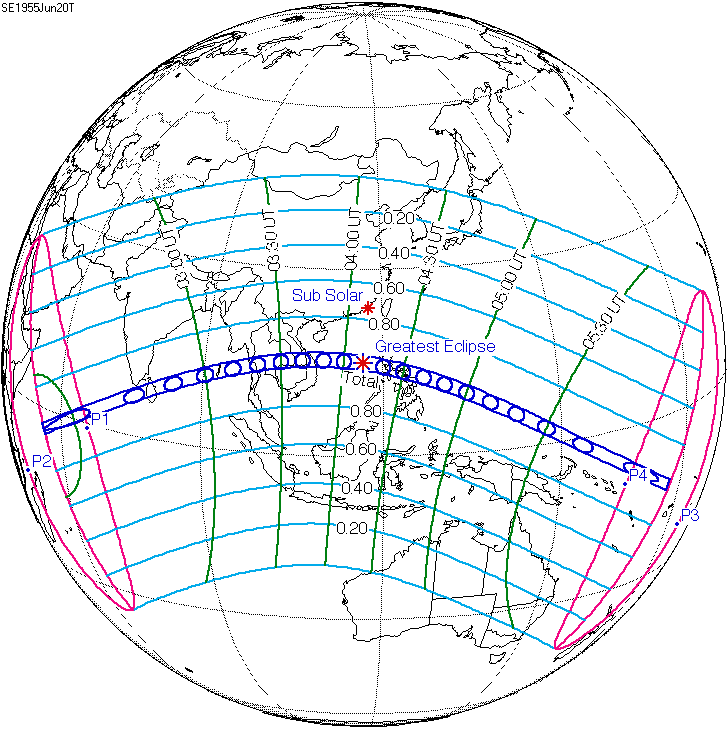
Image Credit: Fred Espenak / NASA GSFC
9. Northwestern United States - Solar Eclipse of 1979
This eclipse was the last total solar eclipse visible over the United States in the 21st century. It also has the distinction of being the first eclipse that received widespread media attention and color views of totality (views of the previous eclipse in 1970 were also in color, however, clouds obscured most of the viewing path). On February 26, thousands flocked to the Pacific Northwest for what was, for many, the last opportunity to see an eclipse in the United States in their lifetimes.
The eclipse first fell upon the coastline of Oregon and Washington, crossing into Idaho and Montana, before heading out over Canada and into Winnipeg - the last total solar eclipse visible in Canada until the year 2008. The next total solar eclipse that was visible over the United States was the 2017 solar eclipse nearly 40 years later. Walter Cronkite would later remark during his ABC News Special Report of the eclipse his hope that the 2017 solar eclipse would see “the shadow of the moon fall on a world of peace”.
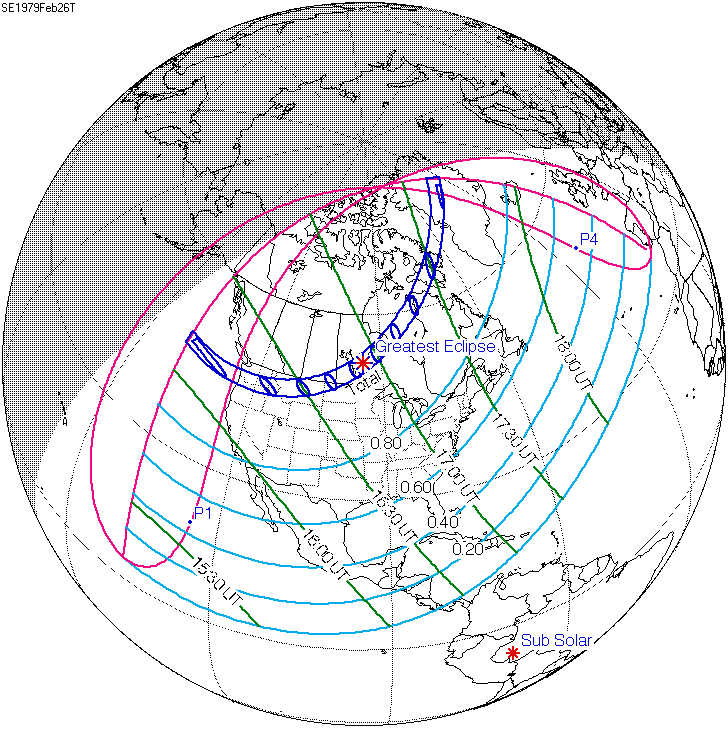
Image Credit: Fred Espenak / NASA GSFC
8. Central and South America Plunged into Darkness - Solar Eclipse of 1991
The Maya were diligent in their documentation of astronomical phenomena, preserving records through hieroglyphs engraved on stone, depicted on pottery and murals, and written in codices made from folded bark. Among these records are accounts of eclipses, a significant part of Maya astronomical observations. These records were so accurate that they were able to predict solar eclipses many centuries in advance, such as the one in 1991 that was visible over Central America. In the book "Astronomy in the Maya Codices" by Harvey and Victoria Bricker, it is demonstrated that the Maya successfully predicted the occurrence of the July 1991 solar eclipse.
This deep solar eclipse, lasting nearly 7 minutes in duration, began its journey over the Pacific near Hawaii. It then crossed over Baja California, Mexico, portions of Nicaragua, and Panama, before heading out over South America and terminating over Brazil.
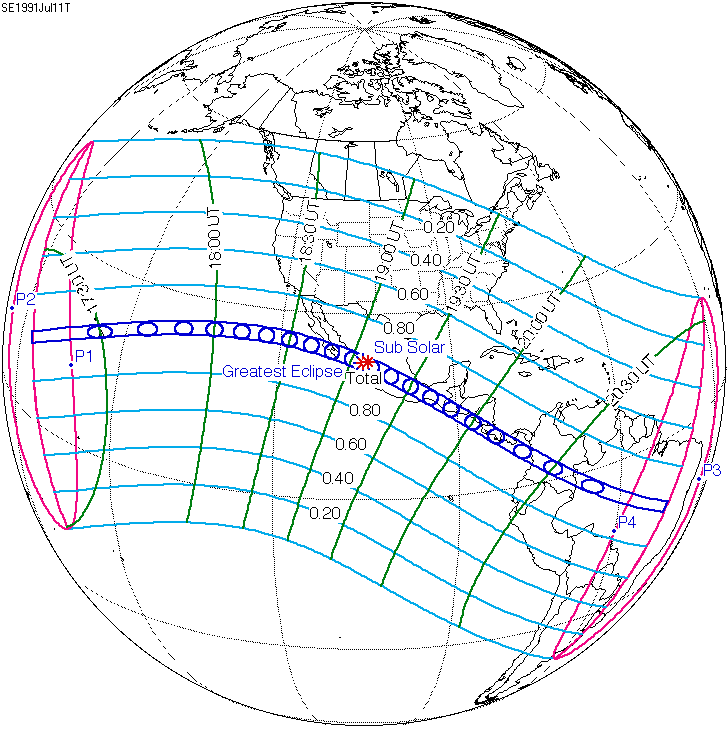
Image Credit: Fred Espenak / NASA GSFC
7. Great American Solar Eclipse of 2024 - Solar Eclipse of 2024
We considered rating this eclipse much higher than where it is. After all, lasting nearly twice as long as the 2017 eclipse while being visible to millions more people would make it a shoo-in for an unforgettable, perhaps even defining, celestial event for the United States. However, the number of clouds, especially in the Northeastern United States, may be a significant showstopper for many.
On April 8, 2024, the eclipse will begin its journey in the late morning on the Pacific coast of Mexico, near Mazatlán. As it progresses, the shadow of the Moon will sweep across the Gulf of Mexico, reaching the shores of Texas. Spectators in cities such as Dallas, Austin, and San Antonio will witness the Moon gradually obscuring the face of the Sun, leading to a remarkable total eclipse experience.
Continuing its trajectory, the path of totality will advance northeast, embracing regions such as Oklahoma, Arkansas, Missouri, and Illinois. The vibrant city of Little Rock in Arkansas, along with St. Louis in Missouri, will find themselves engulfed in darkness as the Moon completely conceals the Sun.
As the eclipse progresses further, the shadow's journey will extend across the breadth of the country. The path of totality will traverse through major cities like Indianapolis, Cleveland, and Buffalo, casting a surreal darkness upon these urban landscapes. Ultimately, the eclipse will reach its final destination over the northeastern states, captivating the skies above regions including northern Vermont, New Hampshire, and Maine.
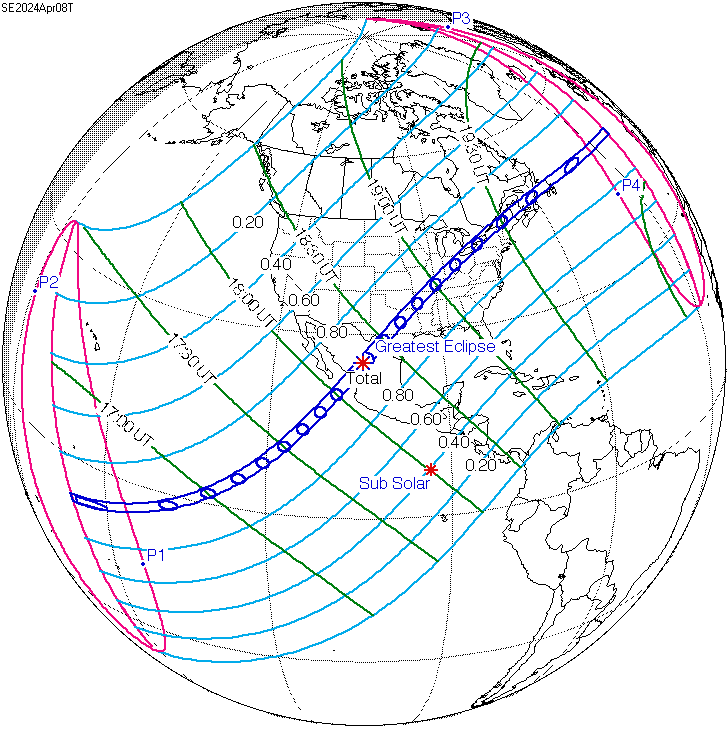
Image Credit: Fred Espenak / NASA GSFC
6. Sunset Solar Eclipse - Solar Eclipse of 2019
This eclipse is the most recent on our list, having occurred on July 2, 2019. There are several reasons why this eclipse makes the list. For one, those observing the eclipse in Chile and Argentina were treated to a beautiful “sunset” solar eclipse, with the sun just above the horizon during totality. This provided a stunning display for those on the ground.
Secondly, the eclipse occurred over some of the locations with the darkest skies in the world - including over the location of the European Southern Observatory, which hosted a live viewing party of the event. Stargazers around the world flocked to South America for a chance to enjoy the most beautiful night sky in the world in conjunction with a total solar eclipse.
Lastly, this was the last solar eclipse before the COVID-19 pandemic struck, which made travel to other solar eclipses - like the 2020 eclipse - extremely difficult, if not impossible. As such, for many years, this was the last solar eclipse that “Eclipse Chasers” could easily be able to travel to before travel restrictions came into place. This solar eclipse began over the Southern Pacific, and traversed over Pitcairn Island, before terminating over South America.
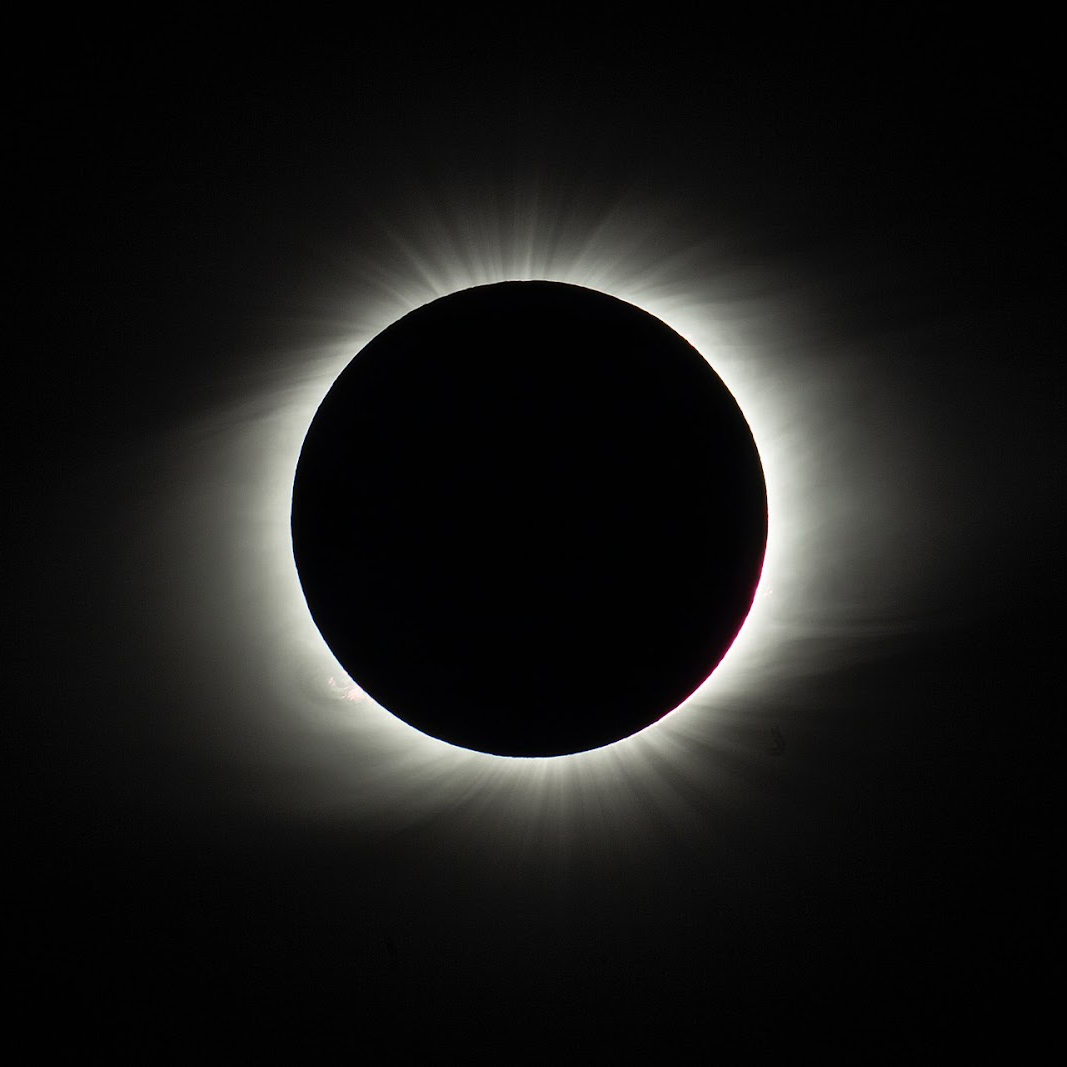
Image Credit: ESO/P. Horalek
5. Great Eastern Hemisphere Eclipse - Solar Eclipse of 2027
This eclipse could be a contender for the most viewed solar eclipse in the 21st century. Viewers in portions of Europe, Africa, and the Middle East will be witness to a very deep solar eclipse on the afternoon of August 2, 2027. This eclipse will be notable because it will pass over several major cities, such as Luxor – the site of Thebes – in Egypt; Jeddah and Mecca in Saudi Arabia; Sana’a; as well as other major cities in this region of the world. Additionally, the path of the eclipse will just barely miss Cairo to the south. As a result, this eclipse has the potential to reach millions of people in Africa.
The eclipse will begin out in the Atlantic early in the morning. It will then cross directly over the Strait of Gibraltar between Spain and Morocco. It will then traverse over portions of northern Algeria and central Tunisia, before heading eastwards directly through the heart of Egypt, the western portions of Saudi Arabia, and Yemen, before heading out into the Indian Ocean and terminating south of Malaysia.
In addition to its large viewing audience, this eclipse will be a long one, clocking in at 6 minutes and 23 seconds at its peak over Egypt. This makes it one of the longest total solar eclipses of the century! Additionally, weather prospects look great across Africa, making the odds of seeing this eclipse very high.
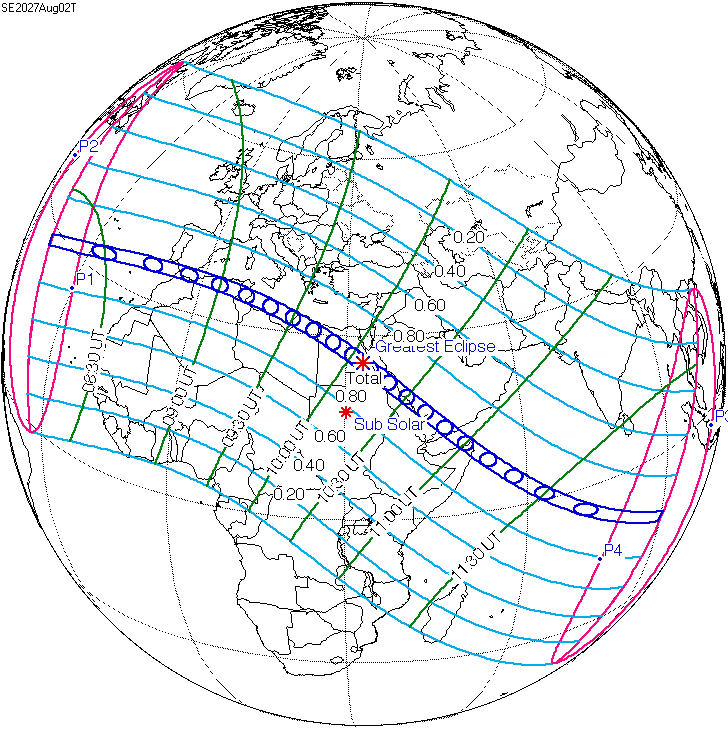
Image Credit: Fred Espenak / NASA GSFC
4. Great American Solar Eclipse - Solar Eclipse of 2045
This eclipse will combine aspects of the 2017 and 2024 eclipses as far as visibility goes. It will follow a very similar path across the United States - beginning over northern California, where cities like Sacramento will enjoy landfall of the eclipse early in the morning. From there, the eclipse will traverse over cities like Denver, and Little Rock, and then head out into the Southeastern United States, over cities like Tampa, Orlando, and Miami. Caribbean countries like Haiti and the Dominican Republic will also be able to enjoy this eclipse. Additionally, this solar eclipse will be much longer than the 2017 or 2024 eclipse, this eclipse will last over six minutes long! This eclipse will certainly be one of the best in the 21st century for the United States.
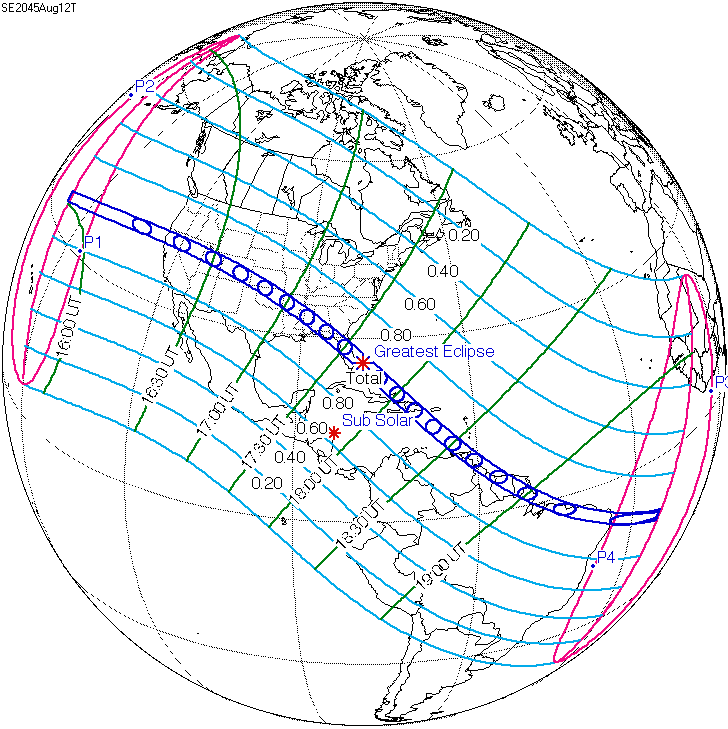
Image Credit: Fred Espenak / NASA GSFC
3. Europe’s Total Solar Eclipse - Solar Eclipse of 1999
The Solar Eclipse of 1999 was one of the most viewed in human history due to high population densities along its path. Some areas experienced impaired visibility due to adverse weather conditions. Various organized eclipse-watching parties set up video projectors for people to observe the Moon's shadow. The BBC focused its coverage on Cornwall, but the eclipse was clouded out.
However, there were good viewing conditions in places like Mid-Channel, Alderney, and Vouziers. In France, the sky cleared just minutes before the eclipse in Amiens but cleared a short time before the shadow arrived in Vouziers. The San Francisco Exploratorium featured a live webcast from Amasya, Turkey. The Bulgarian Academy of Sciences used a MiG-21 aircraft to study the solar corona. Lake Balaton in Hungary fell entirely into the path of the eclipse, attracting many tourists. Several Concordes, including one French and two British, followed the eclipse with tourists on board, greatly extending the length of the solar eclipse for observers on the speedy planes!
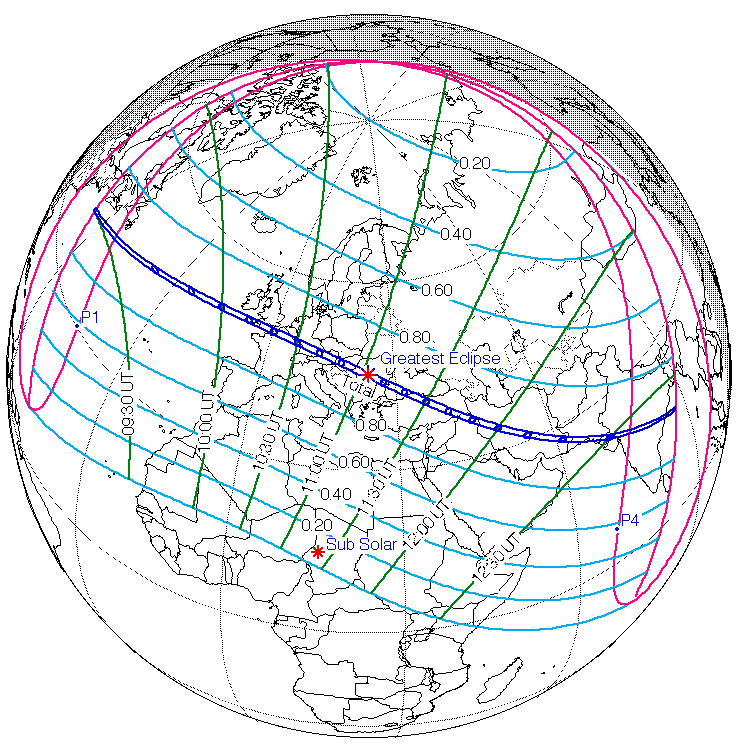
Image Credit: Fred Espenak / NASA GSFC
2. Great American Solar Eclipse - Solar Eclipse of 2017
Anticipation was sky-high in 2017 in the United States for this total solar eclipse. This was the first solar eclipse over the USA in over 38 years - the last being in 1979. Additionally, this was the first “cross country” eclipse since June 8, 1918. States from the west coast to the east coast were on hand to witness this solar eclipse. Hundreds of thousands flocked to parks, NASA-hosted eclipse events, and science centers across the entire country. The excitement for this eclipse also brought a shortage of eclipse glasses.
The eclipse delivered the excitement. The weather was mostly clear across the United States in the path of totality, with the exception of portions of the Midwest. A generational show was put on for those on the ground viewing this eclipse. NBC, NASA TV, and ABC News coverage generated millions of views. Viewers on the ground saw a stunning display of the solar corona expanding across the entire sky. The eclipse first made landfall over the West Pacific coastline. Then the eclipse moved into Idaho, Wyoming, Nebraska, and Missouri. Heading eastwards, the eclipse eventually peaked over Kentucky, before heading out into South Carolina and out into the Atlantic Ocean.

Image Credit: Fred Espenak / NASA GSFC
1. Einstein’s Triumph - the Solar Eclipse of 1919
Number one on our list isn’t a particularly stunning or highly viewed solar eclipse. Indeed, other than in remote locations of Africa and Brazil this eclipse was much more difficult to travel to view. However, this solar eclipse marked the beginning of a scientific revolution - Einstein’s Theory of General Relativity was validated through this solar eclipse.
Einstein predicted that light from distant stars would appear to be “bent” as a result of the gravity of the Sun, due to the nature of gravity bending space and time. The only practical way to test this theory in 1919 was through a total solar eclipse, as the stars would otherwise be blocked by the intense glow of the Sun. Sir Arthur Eddington set out to the island of Principe, off the coast of Africa, in the path of this solar eclipse to test it out. Another astronomer, Andrew Claude de la Cherois Crommelin, was stationed in Brazil.
Einstein’s Theory was completely validated by this eclipse. Images taken of the stars in the region surrounding the Sun, when compared to photographs of the same region of the sky a few months prior, showed a very subtle shift in their position in the sky that increased the closer the star appeared to the Sun. This could only be explained by the gravity of the Sun “tugging” the light from the stars as it passes by on its way to Earth. The General Theory of Relativity set the cornerstone of modern astrophysics, including black holes!

Image Credit: Sir Arthur Eddington
The top 10 solar eclipses worldwide, as explored in this article, showcase the remarkable beauty and scientific significance of these phenomena. From the longest solar eclipse on record in 1955 to the groundbreaking validation of Einstein's Theory of General Relativity in 1919, each eclipse has left its mark on history and on the viewers who witnessed it on the ground.
The selection process for these eclipses considered factors such as the number of people who could witness them, their scientific impact, and the duration of the total solar eclipse. These criteria aimed to highlight eclipses that garnered significant attention, contributed to scientific advancements, and provided ample viewing opportunities.
It is important to note that this list is subjective, and there are numerous other remarkable solar eclipses that deserve recognition. Each eclipse holds its own charm and allure, and individuals may have their personal favorites based on their experiences and interests.

Any Questions? Contact Us!
Witnessing a solar eclipse requires careful planning and consideration of factors such as the path of totality and optimal viewing conditions. Check out our AstronomyHub to learn more about solar eclipses, including where to purchase eclipse glasses for the next solar eclipse!










